Naturalist’s Notebook: August 09 – August 15
Another really fascinating creature that we see sometimes is the Mola mola. Commonly called the ocean sunfish, this animal is nearly rounded in shape (hence the latin meaning “grindstone”). With its caudal fins reduced to a leathery flap, this fish swims by rhythmic motions of its elongated dorsal and anal fins, appearing to fly beneath the surface. In warmer waters it is known to be quite the powerful swimmer but, here where the waters are colder, it moves much slower and, at times, can be completely at the mercy of the currents.
It has leathery skin and a beak-like mouth that it uses to pluck jellyfishes and comb-jellies from the water. Without scales, its skin is covered by a layer of thick mucus. It exhibits the usual countershading for ocean fishes. At times that is not easy to see. Here they spend a good deal of time lying at the surface on their sides, taking in the sunshine. They are really sunbathing, though not for the same reason you or I might. As cold blooded animals, their body temperature (and thus their metabolism) is dictated by the temperature of their surroundings. Basking in the sunshine allows them to raise their body temperature.
It is one of the largest of the bony fish. And for a fish that can reach a diameter of ten or more feet and weigh over a ton and a half, it starts off as very small larval stages that have spiny plates and globe-like bodies.
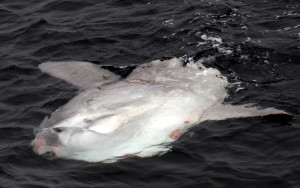
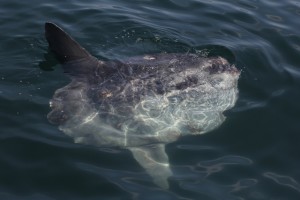
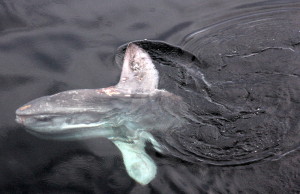
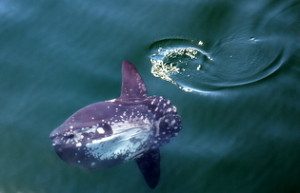
Weather played a big factor in the whalewatches of this week. Big seas caused by both chop and swell are mentioned throughout the week. The two trips of August 09, report a half dozen or so finwhales feeding beneath clouds of birds and a very surface active calf that was tailbreaching, lobtailling, and flipperslapping.
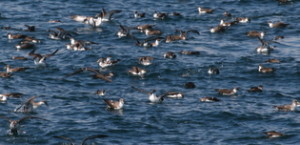

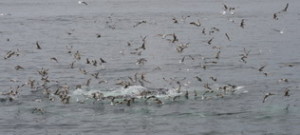
The flipperslapping and feeding of the humpback whales apparently took second place to the Common Dolphins sighted on August 10. Three of the four naturalists today say they were the highlight of the afternoon trip.
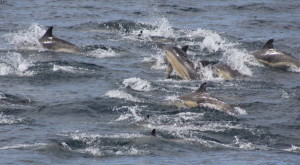
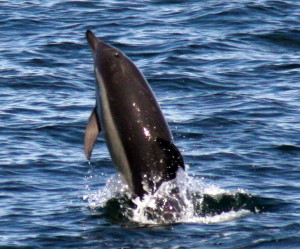
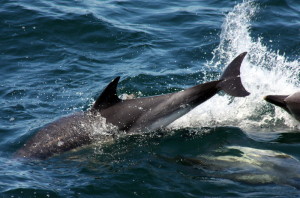
Again on August 11, the weather played a big role. Drenching rains and a bit of wind in the morning put a bit of a damper on the passengers of the Dolphin 7, Dolphin 8, and Dolphin 10. That is until they say the 16 to 20 finback whales around Race Point. And of course, the flipperslapping and chin breaching humpback whale calf. Everyone seemed to agree that braving the weather was well worth it today.
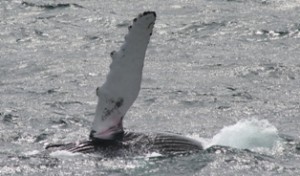
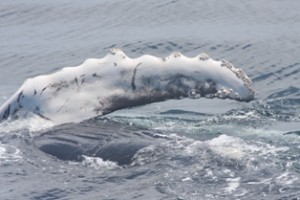
Even Mark Gilmore had to admit that the encounter the Dolphin 9 had with the Minke whale on August 12 outshined the feeding tailbreaching of the humpback whales.
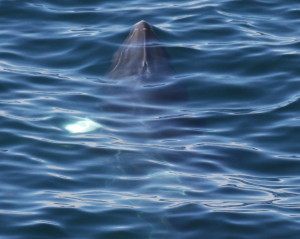
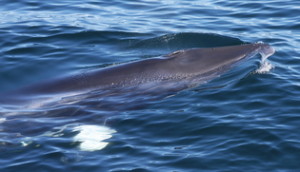
He says, “Shazaam—at Race Point, on way in, second trip, a Minke whale came alongside at 9:00 [directly off the port side of the boat] about 30 feet way and matched our speed at 19 mph. It raced along with us in glass calm water just feet beneath the surface for about two minutes, porpoised out of the water, and shot under the boat. Next thing we knew it is surfing our starboard wake about 50 feed away and rode with us alomost to Wood End.” I have worked alongside Mark Gilmore for twenty years and anything that makes him say, “shazaam” is definately the highlight of any day on the water.
Unless, of course, John Conlon is on the water. He was aboard the Dolphin 7 on that same day and, though he reports sightings of humpback whales, his report was full of the looks his passengers had at a finback whale named Pinch and her second known calf. This finner has been sighted every year since 2007, including in 2008 with her first known calf, named Highway.
August 13 was full of reports of three species trips. Humpback whales, finback whales, and minke whales were reported on nearly every trip made that day. Nancy Scaglione-Peck says that in the middle of the afternoon, they all sort of ganged up around Peaked Hill and were feeding in a small area.
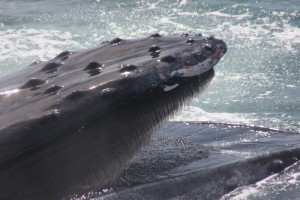
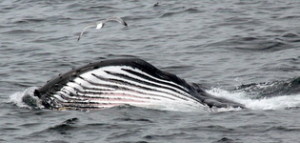
The breaching of the humpback whales, including Salt, Buckshot, Owl, and her 2015 calf, on August 14, were overshadowed by the sighting of an entangle humpback whale. It was spotted first on the afternoon voyage of the Dolphin 10. The vessel, and the naturalist on board, began the task of standing by the animal and taking photographs to assess the severity of the entanglement. As an educator, it is a wonderful opportunity to explain how the activities of man, even when quite unitentional, can have a huge impact on the livelihood of other creatures. As a researcher, it allows us to explore and better understand why nearly forty percent of the humpback whales in the study population show scars from entanglements. As somebody that works on the water and spends time studying these creatures as individuals, and gets to know them as such, it is an exercise in stress and frustration. As educators, emotional involvement makes it much easier to bring your passengers to where you want them to be. As scientists, emotional involvement clouds your judgement. As naturalists, we are kind of caught in the middle. We may, indeed, not become a part of their lives, but they do, in fact, become very much a part of ours. In that situation, it can be very difficult to balance the many hats we wear.
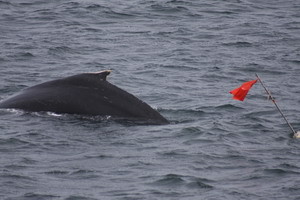
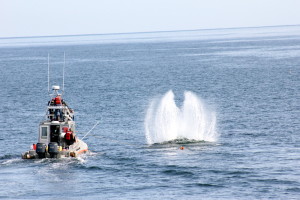
I remember the first time I saw a entangled whale from the whalewatch boat. As the teacher, I was suddenly given a wonderful opportunity to bring my passengers to a new plain. As the data collector, I fired off photos beyond counting, hoping to score the shots that help us better understand how whales get wrapped in gear. But, as the guy that knew that whale and had watched it since the year of its birth, I felt utterly useless. In the back of my mind I knew that nothing I did, beyond keeping the Captain from leaving, was going to increase that whale’s chances of being freed from that gear that day. It is nerve-racking. And so is the knowledge that if you can’t keep yourself together enough, the captain will have no choice except to continue on.
And I also remember my intense feeling of relief when the Ibis showed up.
August 15 was an excellent opportunity to discuss the many possible reasons for whales to breach. In the morning and the late afternoon, the adults were occupied with feeding on fish that was deep beneath the surface, allowing the calves an opportunity to stretch their muscles and play. Breaching is thought to be one way that calves play and exercise. Like many of the games we played when we were young, it is likely a way that they learn to do things they will need to do as adults and exercise the muscles needed to do them.
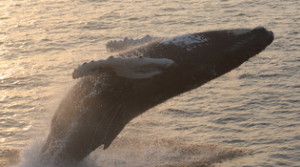
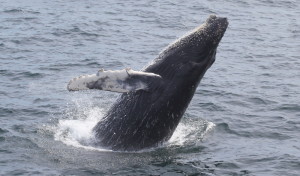
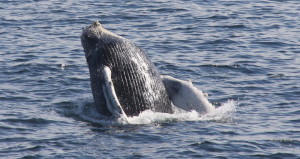
In the early afternoon, a couple of logging (resting) humpback whales were disturbed when a small vessel dragging fishing gear pulled its gear to close. One of the whales responded by breaching. One of the reasons whales are thought to breach, as adults, is to communicate with other whales and with other things in their immediate environment. Sound travels extremely well in the water so whales breaching to communicate with other whales can be miles apart. But when a whale is responding to something like a boat, it is more of a visual memo than an audio one. These particular guys apparently got the message. They were next seen reeling in their lines as fast as their reel could handle.
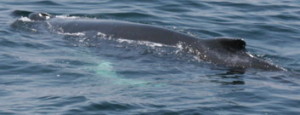
Whales also breach to groom themselves. If you go to an area where one has been breaching and put a dipnet into the water, you can usually put out dead skin and barnacles and parasites that got knocked off by the collision between whale skin and water surface.
Also today, the youngsters aboard the Dolphin 10 were introduced to Green Crabs. Many of them had had experiences with other types of crabs before this trip, but green crabs have a way of bringing out the curiosity of the young, as well as the young of heart. Many questions were asked by both the naturalist and passengers alike as they gathered behind the wheelhouse of the Dolphin 10 in a small huddle.





